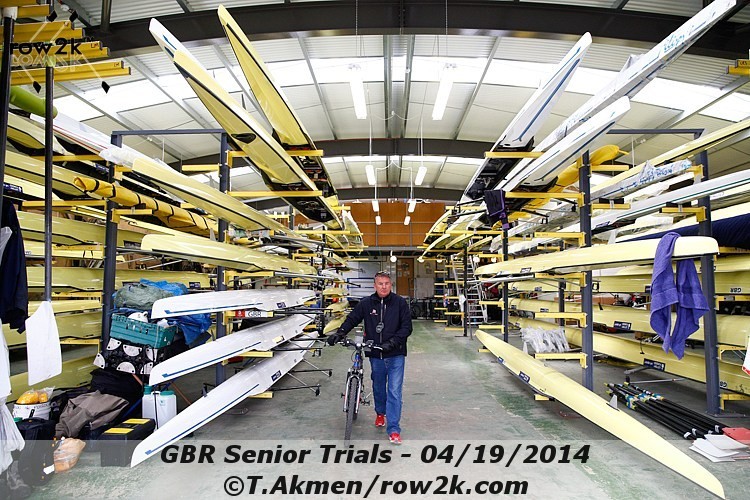
Following is another excerpt from Mike Davenport's posts designed to help rowing folks make the most of this downtime in the sport; read the full article at Rowing Racks: Where your rowing equipment spends 95% of its life.
The equipment you count on to glide you through the water is lounging away in a rowing rack almost its entire life. A life which looks something like this:

Rowing shell racks
Dent-time happens when boats are in racks. It is not uncommon for hulls to suffer a series of small insults while racked.
The main culprits are the riggers from the boat in the rack above. If that boat above is not moved carefully then the hull underneath can end up with scrapes, dents or punctures.
Oar Racks
Like boats, oars need to be stored when not rowed. There are several different ways to store oars: vertically in racks with spoons down (weight supported at collars); vertically in racks with spoons up (weight supported by handle butt); horizontally laying on the side (weight supported by shaft).
 |  |  |
Oars are awkward at best when off the water and, like boats, oars can suffer damage. But a quality rack can greatly reduce that.
What to look for in a rack
For boat racks, look for:
- Racks designed and built to handle more weight than just the weight of the shell(s). (You have to take into account weight put on the racks from moving)
- Boat properly supported (2 beams for a four or smaller boat, 3 beams for an eight)
- Space between racks is large enough so boats can be moved in/out (need several inches of clearance between hulls and riggers from boat above/below)
- Beams are padded (prevents damage to gunwales and reduces unwanted moving of boat)
- For boats stored outside, the boat should be able to be securely strapped (to reduce wind damage) and covered (to reduce UV damage)
For oar racks, look for:
- Racks designed to keep sets of oars together
- For oars stored vertically with blades-up, the handle butt should be on material (such as wood or padding) and not on floor
- For oars stored vertically with blades-down, the blade tip should elevated off the ground
- For oars stored horizontally, beams should be set a distance apart so oars lay balanced
![]()
For thoughts on the best ways to store oars, read Mike's original article.
Inspect your rowing racks
Inspecting your racks can be a challenge, because most times they will have equipment in them. So for your inspect either schedule it when equipment is being rowed, or in transit, or bring a work party with you to move things around.The 3 main areas to check on your boat racks are:
- The beams—are they all at the same height so the boat sits level?
- The fasteners—are they all tight?
- The padding—is it securely attached to the beam and-of good quality?
Three questions to ask about your oar racks are:
- Is the oar safely supported and won’t fall out of the rack?
- Are there areas where the oar could get damaged? Like if stored blades-up the tips could be damaged at the top
- Is the rack clearly labeled for the set of oars that is assigned to it?
For ideas on repair and replacement of your racks, read Mike's original article.
Actions steps: a review
After many years of dealing with homemade racks in our boathouse, we finally reached the end of our patience.We had spend about hours-upon-hours leveling and padding beams and realized that our best efforts were not going to be good enough.
So we took the plunge, signed a contract, and in 4 weeks we had a brand new, sturdy, safe, and perfectly level rack system. It was so nice I actually had a party. Here are the action steps in your review:
- Inspect rowing shell racks: Fasteners tight? Are beams level? Padding in good shape? Clearance between racks sufficient? Are shells in outdoor racks secure?
- Inspect oar racks: Oar handles or blades off the ground? Blade tips protected? (Bonus tip: for racks with low clearance, put bumpers on the riggers, like this simple design at CRI)
- Complete needed repairs
- Make any purchases
To learn more about rigging, check out Mike's new book Get Ready To Row: A Rowing Equipment Roadmap To Make Your Next Season Hassle Free - due out this summer, keep an eye at MaxRigging.com.
If you enjoy and rely on row2k, we need your help to be able to keep doing all this. Though row2k sometimes looks like a big, outside-funded operation, it mainly runs on enthusiasm and grit. Help us keep it coming, thank you! Learn more.
Comments | Log in to comment |
There are no Comments yet
| |
- Bont Rowing
- Calm Waters Rowing
- Concept 2
- Craftsbury Sculling
- The Crew Classic
- CrewLAB
- Croker
- Durham Boat Co.
- Empacher
- Faster Masters
- Filippi
- Fluidesign
- h2row.net
- HUDSON
- Live2Row Studios
- Nielsen-Kellerman
- Oak Ridge RA
- Peinert Boat Works
- Pocock Racing Shells
- Race1 USA
- RowKraft
- Rubini Jewelers
- Vespoli USA
- WinTech Racing
- Bont Rowing
- Calm Waters Rowing
- Concept 2
- Craftsbury Sculling
- The Crew Classic
- CrewLAB
- Croker
- Durham Boat Co.
- Empacher
- Faster Masters
- Filippi
- Fluidesign
- h2row.net
- HUDSON
- Live2Row Studios
- Nielsen-Kellerman
- Oak Ridge RA
- Peinert Boat Works
- Pocock Racing Shells
- Race1 USA
- RowKraft
- Rubini Jewelers
- Vespoli USA
- WinTech Racing


















